Back to Journals » International Journal of Women's Health » Volume 14
The Correlation Between Three-Dimensional Ultrasound Measurement of Fetal Adrenal Gland and Maternal Serum Fructosamine Level in Gestational Diabetes Mellitus: Prospective Cohort Study
Authors Junhasavasdikul S, Panburana P , Bumrungphuet S , Dulyaphat W
Received 7 May 2022
Accepted for publication 26 September 2022
Published 17 October 2022 Volume 2022:14 Pages 1465—1476
DOI https://doi.org/10.2147/IJWH.S373087
Checked for plagiarism Yes
Review by Single anonymous peer review
Peer reviewer comments 2
Editor who approved publication: Dr Everett Magann
Saowapak Junhasavasdikul, Panyu Panburana, Sommart Bumrungphuet, Wirada Dulyaphat
Department of Obstetrics and Gynecology, Division of Maternal Fetal Medicine, Faculty of Medicine, Mahidol University, Ramathibodi Hospital, Bangkok, Thailand
Correspondence: Wirada Dulyaphat, Division of Maternal-Fetal Medicine, Department of Obstetrics and Gynecology, Faculty of Medicine, Ramathibodi Hospital, Mahidol University, Bangkok, 10400, Thailand, Tel +66-873017028, Fax +66 02-2011416, Email [email protected]
Objective: Gestational diabetes mellitus (GDM) has an impact on fetal adrenal gland size and volume, which are greater in the GDM population. This study used 2D and 3D ultrasound scanning to determine the correlation of fetal adrenal gland size and volume with fructosamine levels, HbA1c levels, estimated fetal weight (EFW), and neonatal birth weight in GDM patients.
Methods: This study included eighty singleton pregnant women diagnosed with GDM between 24– 28 weeks of gestation. During weeks 32– 34 of gestation, the length, width, and depth of the fetal zone and total adrenal gland were measured using transabdominal 2D ultrasound. Virtual organ computer-aided analysis (VOCAL) software was used to evaluate fetal zone and total adrenal gland volume in 3D ultrasound. All the participants were followed until delivery. Pearson’s correlation analysis was conducted to examine the correlation between fetal adrenal gland ultrasound measurements and the factors of interest.
Results: The study consisted of sixty-six (82.5%) pregnant women with diet-controlled GDM (GDMA1) and fourteen (17.5%) pregnant women with insulin-managed GDM (GDMA2). There was no difference in fetal adrenal gland measurements between the diet-controlled (GDMA1) and the insulin-managed (GDMA2) groups. All the participants had achieved optimal glucose levels at the time of ultrasound acquisition. The total adrenal gland length and fetal zone volume had statistically significant positive correlations with EFW (r = 0.69, p = 0.02 and r = 0.84, p = 0.01, respectively). After adjusting for EFW, only the fetal zone volume was significantly correlated with fructosamine levels (adjusted-OR = 2.4, 95% CI: 1.5, 3.9, p = 0.01) and HbA1c levels (adjusted-OR = 2.5, 95% CI: 1.6, 4.3, p = 0.01).
Conclusion: The fetal zone volume is correlated with EFW, fructosamine levels, and HbA1c levels. This non-invasive technique may be beneficial as an indirect marker for glycemic monitoring in GDM.
Keywords: fetal adrenal gland, three- dimensional ultrasound, two- dimensional ultrasound, fructosamine level, correlation, gestational diabetes mellitus
Introduction
Gestational diabetes mellitus (GDM) is traditionally defined as glucose intolerance that develops or is first recognized during pregnancy based on defined thresholds lower than those considered for overt diabetes.1 The prevalence of GDM varies between 1.6 −34.9% worldwide, depending on the population studied and the diagnostic criteria used.2 The prevalence of GDM is increasing worldwide.3–6 Poor glycemic control has been related to substantial short- and long-term consequences for both women and their offspring.7,8 Maintaining good glycemic control is key to reducing the incidence of diabetes-related complications. Fasting blood glucose, postprandial blood glucose, and hemoglobin A1c (HbA1c) are common markers of glycemic control. However,
blood glucose concentrations fluctuate substantially due to many causes, such as acute stress and recent feeding status.9 Fructosamine, which is a measure of non-enzymatic glycation of circulating proteins, has advantage over HbA1c since it is not affected by iron deficiency from pregnancy, hemoglobin turnover, and some medications.9,10 In addition, it has been used in GDM screening and monitoring because it reflects glycemic control in the 2 −3 weeks prior to testing, while HbA1c indicates glycemic status in the past 2 −3 months.10–12
The fetal adrenal gland is an active endocrine organ and serves as one of the most important glands in the body system. It is a key component of the feto-placental unit, which promotes maternal and fetal homeostasis.13 During the latter two -thirds of gestation, fetal adrenal glands have an extraordinarily rapid growth rate with steroidogenic activity.14 Fetal adrenal glands are principally composed of two main distinct zones in the adrenal cortex: the outer definitive zone (DZ) and the inner fetal zone (FZ). Each zone has a different functional maturation with ontogeny of expression of specific steroidogenic enzymes. The definitive zone— also referred to as the adult cortex, neocortex, or permanent zone—is comprised of a narrow band of tightly packed cells that surround the fetal zone. This zone is the site of cortisol, dehydroepiandrosterone sulfate (DHEA-S), and mineralocorticoid synthesis. The fetal zone, which constitutes 80 −90% of the adrenal gland, is dramatically remodeled during the fetal period, and it atrophies, regresses, and completely disappears in the first few months of life. This zone mainly produces DHEA-S and small amounts of cortisol throughout the rest of gestation.15
Recent studies have shown that GDM, as a metabolic disease that can lead to hyperinsulinemia, has an impact on fetal adrenal gland size, which are more enlarged in women with GDM compared to women without GDM.16,17 However, none of these studies determined which factors were related to fetal adrenal gland size or volume in pregnancies complicated by diabetes. Thus, our objectives were to evaluate the correlation between fetal adrenal gland size and volume observed using two-dimensional (2D) ultrasound measurement in transverse, coronal, and sagittal planes and three-dimensional (3D) ultrasound measurement using virtual organ computer-aided analysis (VOCAL) software and maternal serum fructosamine levels in GDM patients. In addition, the correlations of fetal adrenal gland measurements, including size and volume, with maternal HbA1c levels, estimated fetal weight (EFW), and neonatal birth weight were also included in this study.
Materials and Methods
Participants
This prospective cohort study was performed at GDM clinic in Ramathibodi hospital, Mahidol university from January 2019 to December 2019. The study was conducted according to the guidelines of the Declaration of Helsinki and approved by the Committee on Human Rights Related to Research Involving Human Subjects of the Faculty of Medicine, Ramathibodi Hospital, Mahidol University, Thailand. The participants’ weeks of gestation were determined based on the first day of their last menstrual period, and they were confirmed by the first trimester sonographic examination. Routine ultrasound screening was done during 18–22 weeks of gestation. The pregnant women with maternal or fetal conditions, such as maternal pre-gestational diabetes mellitus, chronic hypertension, cirrhosis, fetal anomalies, and intrauterine growth restriction, were excluded. Eighty-four singleton diabetic pregnant women, diagnosed through a universal screening using 75-g oral glucose tolerance test (OGTT) at 24 −28 weeks of gestation, were invited to participate and asked to provide their written informed consent. All participants were advised regarding lifestyle behavior changes, dietary modifications, and instructions for self-glucose monitoring. If their daily blood glucose levels could not be controlled, the endocrinologist was consulted to initiate treatment with insulin. All participants were followed until delivery with standard antenatal, intrapartum, and postpartum care management.
Measurement Protocols
At 32 to 34 weeks of gestation, the participants underwent transabdominal ultrasound examination using a Voluson E8 Expert machine (GE Healthcare) equipped with an abdominal 4–8 MHz curvilinear transducer. Each participant underwent a single examination. Initially, fetal biometry and a structural survey were performed to measure the estimated fetal weight and to ensure that there was no fetal anomaly. The fetal adrenal gland was identified as the oval-shaped structure located superior and medial to the ipsilateral kidneys on the axial plane, with the centrally located fetal zone serving as an echogenic zone, as described in Figure 1A. The fetal adrenal gland that was located closer to the ultrasound probe was selected for imaging analysis, since there are no statistically significant differences between the parameters of the right and left fetal adrenal glands, as shown in a previous study.18 Each patient underwent fetal adrenal gland size and volume measurements using 2D and 3D ultrasounds in a single examination. The technique of measuring the fetal adrenal gland using 2D ultrasound, which was systematically measured in previous research, was implemented in this study.16 The length, width, and depth were measured and recorded on the axial, coronal, and sagittal planes, respectively. The length (L), width (W), and depth (D) of the total adrenal gland, as well as the length (l), width (w), and depth (d) of the fetal zone, were measured. Three consecutive measurements (in millimeters) of the total adrenal gland and the fetal zone were obtained by placing the calipers from the outer border to the opposing outer border, as demonstrated in Figure 1B–D. The mean of the values was calculated for the statistical analysis. The fetal zone total adrenal gland ratio of each measurement (w/W, l/L, and d/D) was used to control for variation in adrenal size by gestational age.
VOCAL software was applied to evaluate the volume of the fetal adrenal gland in 3D (General Electric Medical Systems, Milwaukee, WI). Two independent volumes were obtained for both the total adrenal gland and the fetal zone, as characterized by the outer anechoic gland and echogenic inner core, respectively. The 360-degree adrenal gland volume was outlined manually from 24 different planes with 15-degree rotations of the volume around the central axis, as described in Figure 2A–B. The mean of three consecutive total and fetal zone volumes were computed for the statistical analysis. The ratio of the fetal zone to total volume was calculated. The corrected adrenal gland volume (c-AGV) was also calculated by dividing the total adrenal gland volume by the estimated fetal weight.
 |
Figure 2 Demonstration of fetal adrenal gland volume: the fetal zone volume (A), the total adrenal gland volume (B). |
Intraobserver reliability was maintained by ensuring that the same operator conducted the three consecutive measurements. In addition, two complete measurements were compared between two blinded operators to ensure interobserver reliability. The intraobserver and interobserver variations calculated using the interclass correlation coefficient in 10 random cases, were 0.89 (95% CI: 0.82, 0.98) and 0.84 (95% CI 0.74, 0.97), respectively, which indicated high intraobserver and interobserver reliability.
Laboratory Investigation
A maternal peripheral venous blood sample was collected on the day of the fetal adrenal gland measurement, and fructosamine and HbA1c levels were tested. The maternal fructosamine levels were determined using a colorimetric nitro blue tetrazolium (NBT) assay from Roche, and maternal HbA1c levels were measured using immunoassays, such as the Tina-quant® HbA1c assay from Roche. The samples were centrifuged, and the results were reported immediately.
Results
Eight-four eligible pregnant women were recruited for this study, three of whom were excluded, as their fetal adrenal glands could not be measured properly. Another participant was excluded because she was due to deliver at another hospital. The remaining eighty participants were included in the final analysis.
The mean age of the study participants was 32 ± 5.6 years old (range 26–38 years old). Sixty-six (82.5%) participants had diet-controlled gestational diabetes (GDMA1). The remaining fourteen (17.5%) had insulin-managed gestational diabetes (GDMA2). All the participants had achieved optimal glucose levels using preprandial and postprandial self-monitoring of blood glucose at the time of ultrasound acquisition and delivery. The mean EFW was 1995.9 ± 249.7 g (range 1746–2246 g). Maternal demographic data, maternal biochemical markers, EFW by ultrasonography, and neonatal outcomes are shown in Table 1.
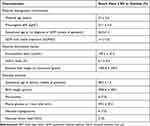 |
Table 1 The Maternal, Fetal and Neonatal Demographic Data |
In 2D ultrasound measurements, the mean length (l), width (w), and depth (d) of the fetal zones were 17.25 mm, 2.62 mm, and 1.46 mm, respectively. The mean length (L), width (W), and depth (D) of the total adrenal glands were 23.19 mm, 5.56 mm, and 3.59 mm, respectively. The ratio between fetal zone and total adrenal gland lengths, widths, and depths were 0.74, 0.46, and 0.41, respectively. In the 3D ultrasound measurements, the mean fetal zone and total adrenal gland volumes were 367.11 mm3and 1278.45 mm3, respectively. The ratio between fetal zone volume and total adrenal gland volume was 0.32. The c-AGV was 0.63. The comparison of adrenal gland measurements between the GDMA1 and GDMA2 groups is presented in Table 2. There was no difference in fetal adrenal gland measurements between both groups. The fetal adrenal gland measurements in both 2D and 3D ultrasonography are presented in Tables 3–6.
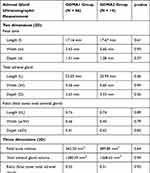 |
Table 2 Comparison of Adrenal Gland Measurement Between GDMA1 and GDMA2 Groups |
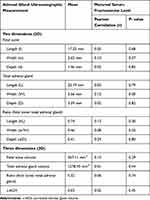 |
Table 3 Pearson’s Correlation Between the Fetal Adrenal Gland Ultrasound Measurement and Maternal Serum Fructosamine Level |
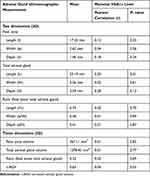 |
Table 4 Pearson’s Correlation Between the Fetal Adrenal Gland Ultrasound Measurement and Maternal HbA1c Level |
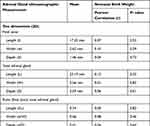 |
Table 5 Pearson’s Correlation Between the Fetal Adrenal Gland Ultrasound Measurement and Neonatal Birth Weight |
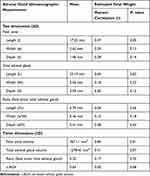 |
Table 6 Pearson’s Correlation Between the Fetal Adrenal Gland Ultrasound Measurement and Estimated Fetal Weight by Ultrasonographic Measurement |
Tables 3–5 shows the correlation between fetal adrenal gland size measured by 2D and 3D ultrasound scanning and maternal fructosamine levels, HbA1c levels, and neonatal birth weight. In 2D ultrasound measurements, the length, width, and depth of the fetal zone and total adrenal gland, along with the adrenal gland ratio, did not show any statistically significant correlation with fructosamine and Hb1Ac levels (p > 0.05). Likewise, the volumes of the fetal zone and total adrenal gland, the adrenal gland ratio, and c-AGV did not demonstrate significant correlations with maternal fructosamine levels, maternal HbA1c levels, and neonatal birth weight (p > 0.05).
The correlation between fetal adrenal gland size obtained using both 2D and 3D ultrasound scanning and EFW is shown in Table 6. In 2D ultrasound measurements, the length of the total adrenal gland (L) showed a statistically significant positive correlation with EFW (r = 0.69, p = 0.02). Through 3D ultrasound measurements, the fetal zone volume was demonstrated to have a statistically significant positive correlation with EFW (r = 0.84, p = 0.01). No obvious correlation was found between the other fetal adrenal gland parameters and EFW.
Table 7 shows the correlation of fetal adrenal gland measurements with the factors of interest—fructosamine levels, HbA1c levels, neonatal birth weight, and macrosomia—after adjusting for EFW. The fetal zone volume was significantly correlated with fructosamine levels (adjusted-OR = 2.4, 95% CI: 1.5, 3.9, p = 0.01) and HbA1c levels (adjusted-OR = 2.5, 95% CI: 1.6, 4.3, p = 0.01). However, there were no statistically significant correlations between fetal adrenal gland measurements and other factors.
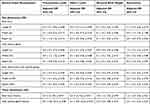 |
Table 7 Adjusted Odds Ratios and 95% Confidence Intervals for Maternal Biochemical Markers and Neonatal Outcomes |
Discussion
The findings of this study indicate that fetal adrenal gland measurements using 2D and 3D ultrasonography in the third trimester can be visualized and measured adequately in 96.4% of the participants. The total adrenal gland length and fetal zone volume are correlated with EFW. After adjusting for EFW, only the fetal zone volume was significantly correlated with both maternal fructosamine and HbA1c levels in well-controlled GDM.
A previous study using 2D ultrasound found that the measurements of fetal adrenal gland size in the axial plane were significantly enlarged in GDM patients compared to non-diabetic pregnant women.17 The enlargement of the fetal adrenal gland in GDM could be explained by the suppression of aromatase activity, which is caused by maternal hyperinsulinemia.19 We hypothesized that maternal blood glucose levels would have an effect on fetal adrenal gland size or volume. We used serum fructosamine as a marker of blood glucose monitoring because it reflects short-term glycemic status, serves as a good tool for monitoring blood glucose levels,12 and has a strong positive correlation with HbA1c levels.20 However, since fructosamine levels are a measure of the non-enzymatic glycation of circulating proteins, including albumin, globulins, and lipoproteins, any conditions that influence serum albumin concentrations, such as liver cirrhosis or nephrotic syndrome, can interfere with the interpretation of the measurement.21 Furthermore, previous studies have reported discordant conclusions about the ability of fructosamine to screen for GDM and its association with postpartum glycemic indices or neonatal outcomes.10,22–24
To the best of our knowledge, there is only one study that demonstrates the relationship between fetal adrenal gland measurements and maternal glycemic status in women with GDM. Garcia-Flores et al measured the fetal adrenal gland sizes and volumes of thirty-nine GDM patients and found that total adrenal gland volume was significantly related to neonatal birth weight and maternal HbA1c levels.16 The authors concluded that fetal adrenal gland enlargement was particularly noticeable in terms of total adrenal gland volume and that the enlargement could be higher in the definitive zone rather than the fetal zone. Furthermore, they found a correlation between total adrenal gland volume and neonatal birth weight but not a correlation between fetal adrenal gland measurements and EFW, which is inconsistent with the findings of our study. In our study, we demonstrated that fetal zone volume and total adrenal gland length were particularly enlarged and correlated with EFW. When adjusting for the EFW, only fetal zone volume was correlated with maternal fructosamine and HbA1c levels. However, the participants in Garcia-Flores et al’s study were quite different from those in our study, as more than half of them received treatment with subcutaneous insulin (GDMA2). In their study, moreover, there was no data comparing fetal adrenal gland measurements in GDMA1 and GDMA2 patients and no record of the blood glucose status of pregnant women at the time of delivery.
We encouraged the 3D ultrasonography technique for measuring the fetal adrenal gland rather than the 2D technique. Although the former is more time-consuming, it is more accurate and more precise for evaluating the fetal adrenal gland due to the gland’s irregular shape. Right adrenal glands were commonly described as an irregular triangle or pyramid while most of the left adrenal glands had a half-moon shape and a pyramidal shape only in a few cases.25
The strengths of this study were its prospective study design, which allowed for the systematic measurement of fetal adrenal glands using 2D and 3D techniques in multiple planes by trained sonographers, and the fact that all the participants were followed until delivery. One limitation of the study is the fact that it is single-centered. Another limitation is the time frame of the assessment, which was done at a specific point between weeks 32 and 34 of gestation. Lastly, all the participants’ glycemic levels were well-controlled, which limits the study as there was a lack of heterogeneity in glycemic levels. Consequently, the correlation between fetal adrenal gland measurements and the poor glycemic status of women with GDM cannot be analyzed. More useful results can be achieved if future studies are multicentered and focus on subgroup analysis of glycemic status. This may be used as a prediction tool to assess the possibility of poor glycemic control or adverse neonatal outcomes.
Conclusions
Our study showed that both total adrenal gland length and fetal zone volume were correlated with EFW. After adjusting for EFW, only the fetal zone volume was significantly correlated with fructosamine and HbA1c levels. These non-invasive techniques may be beneficial as indirect markers for glycemic monitoring in patients with GDM.
Ethics Approval and Informed Consent
The study was approved by the Committee on Human Rights Related to Research Involving Human Subjects, Faculty of Medicine, Ramathibodi Hospital, Mahidol University, Thailand (COA. No. MURA2018/946). Informed consent was obtained from all participants for publication of this study and the images shown.
Acknowledgments
The authors are grateful to the research assistant Maneerat Prakobpanich and all caregivers of the participants who supported this present study.
Funding
This study was supported by Research Fund, Faculty of Medicine, Ramathibodi Hospital, Mahidol University.
Disclosure
The authors have no conflicts of interest to declare.
References
1. World Health Organization. Diagnostic criteria and classification of hyperglycaemia first detected in pregnancy. Available from: https://apps.who.int/iris/handle/10665/85975.
2. Behboudi-Gandevani S, Amiri M, Yarandi RB, Tehrani FR. The impact of diagnostic criteria for gestational diabetes on its prevalence: a systematic review and meta-analysis. Diabetol Metab Syndr. 2019;11(1):1–16. doi:10.1186/s13098-019-0406-1
3. Zhou T, Du S, Sun D, et al. Prevalence and trend in gestational diabetes mellitus among women in the United State, 2006–2017: a population-based study. Front Endocrinol. 2022;13:1–8. doi:10.3389/fendo.2022.868094
4. Su FL, Lu MC, Yang CP, et al. Increasing trend in the prevalence of gestational diabetes mellitus in Taiwan. J Diabetes Investig. 2021;12(11):2080–2088. doi:10.1111/jdi.13595
5. Mdoe MB, Kibusi SM, Munyogwa MJ, Ernest AI. Prevalence and predictors of gestational diabetes mellitus among pregnant women attending antenatal clinic in Dodoma region, Tanzania: an analytical cross-sectional study. BMJ Nutr Prev Health. 2021;4(1):69–79. doi:10.1136/bmjnph-2020-000149
6. Kunasegaren T, Balasubramaniam VRMT, Arasoo VJT, Palanisamy UD, Ramadas A. Gestational diabetes mellitus in southest Asia: ascoping review. Int J Environ Res Public Health. 2021;18(3):1–21.
7. Metzger BE, Lowe LP, Dyer AR, et al. Hyperglycemia and adverse pregnancy outcomes. N Engl J Med. 2008;358(19):1991–2002.
8. Shou C, Wei Y, Wang C, Yang H. Updates in long-term maternal and fetal adverse effects of gestational diabetes mellitus. Matern Fetal Med. 2019;1(2):91–93. doi:10.1097/FM9.0000000000000019
9. Ayyappan S, Philips S, Kumar CK, Vaithiyanandane V, Sasikala C. Serum fructosamine a better indicator than glycated hemoglobin for monitoring gestational diabetes mellitus. J Pharm Bioallied SCI. 2015;7(1):32–34. doi:10.4103/0975-7406.155786
10. Gingras V, Rifas-Shiman SL, Switkowski KM, Oken E, Hivert MF. Mid-pregnancy fructosamine measurement-predictive value for gestational diabetes and association with postpartum glycemic indices. Nutrients. 2018;10:1–11. doi:10.3390/nu10122003
11. Hashimoto K, Koga M. Indicators of glycemic control in patients with gestational diabetes mellitus and pregnant women with diabetes mellitus. World J Diabetes. 2015;6(8):1045–1056. doi:10.4239/wjd.v6.i8.1045
12. Ekhzaimy A, Alkatari S, AlMaatouq M, et al. Fructosamine as an index of short-term glycemic control in pregnant women with diabetes: before, during and after ramadan. Int J Womens Health. 2022;14:435–444. doi:10.2147/IJWH.S351654
13. Ishimoto H, Jaffe RB. Development and function of the human fetal adrenal cortex: a key component in the feto-placental unit. Endocr Rev. 2011;32(3):317–355. doi:10.1210/er.2010-0001
14. Mesiano S, Jaffe RB. Developmental and functional biology of the primate fetal adrenal cortex. Endocr Rev. 1997;18(3):378–403. doi:10.1210/edrv.18.3.0304
15. Seron-Ferre M, Jaffe RB. The fetal adrenal gland. Ann Rev Physiol. 1981;43(1):141–162. doi:10.1146/annurev.ph.43.030181.001041
16. Garcia-Flores J, Cruceyra M, Canamares M, et al. Sonographic evaluation of fetal adrenal gland in gestational diabetes. J Med Ultrasound. 2017;36(5):999–1007. doi:10.7863/ultra.16.03005
17. Hetkamp T, Hammer K, Mőllers M, et al. Fetal adrenal gland size in gestational diabetes mellitus. J Perinat Med. 2019;47(9):941–946. doi:10.1515/jpm-2019-0146
18. Ozgüner G, Sulak O, Koyuncu E. A morphometric study of suprarenal gland development in the fetal period. Surg Radiol Anat. 2012;34:581–587. doi:10.1007/s00276-012-0959-2
19. Nestler JE. Modulation of aromatase and P450 cholesterol side-chain cleavage enzyme activities of human placental cytotrophoblasts by insulin and insulin-like growth factor I. Endocrinology. 1987;121(5):1845–1852. doi:10.1210/endo-121-5-1845
20. Farghali MM, Mahmoud AM, Baidas G, Khalafalla MM, Abdelazim IA, Svetlana S. Serum fructosamine and glycosylated hemoglobin in monitoring the glycemic control in gestational diabetes mellitus. Open J Obstet Gynecol. 2018;8:630–645. doi:10.4236/ojog.2018.86068
21. Gounden V, Ngu M, Anastasopoulou C, Jialal I. Fructosamine [Internet]. Treasure Island (FL): StatPearls Publishing; 2021. Available from. https://www.ncbi.nlm.nih.gov/books/NBK470185.
22. Agarwal MM, Dhatt GS, Othman Y, Ljubisavljevic MR. Gestational diabetes: an evaluation of serum fructosamine as a screening test in a high-risk population. Gynecol Obstet Invest. 2011;71(3):207–212. doi:10.1159/000318705
23. Nasrat HA, Ajabnoor MA, Ardawi MS. Fructosamine as a screening-test for gestational diabetes mellitus: a reappraisal. Int J Gynaecol Obstet. 1991;34(1):27–33. doi:10.1016/0020-7292(91)90534-C
24. Cahill AG, Tuuli MG, Colvin R, Cade WT, Macones GA. Markers of glycemic control and neonatal morbidity in high-risk insulin-resistant pregnancies. Am J Perinatol. 2016;33(2):151–156. doi:10.1055/s-0035-1562929
25. Zhang Z, Meng H, Hou Z, et al. Fetal adrenal gland in the second half of gestation: morphometrical assessment with 3.0T post-mortem MRI. PLoS One. 2013;8(10):1–7.
 © 2022 The Author(s). This work is published and licensed by Dove Medical Press Limited. The full terms of this license are available at https://www.dovepress.com/terms.php and incorporate the Creative Commons Attribution - Non Commercial (unported, v3.0) License.
By accessing the work you hereby accept the Terms. Non-commercial uses of the work are permitted without any further permission from Dove Medical Press Limited, provided the work is properly attributed. For permission for commercial use of this work, please see paragraphs 4.2 and 5 of our Terms.
© 2022 The Author(s). This work is published and licensed by Dove Medical Press Limited. The full terms of this license are available at https://www.dovepress.com/terms.php and incorporate the Creative Commons Attribution - Non Commercial (unported, v3.0) License.
By accessing the work you hereby accept the Terms. Non-commercial uses of the work are permitted without any further permission from Dove Medical Press Limited, provided the work is properly attributed. For permission for commercial use of this work, please see paragraphs 4.2 and 5 of our Terms.

